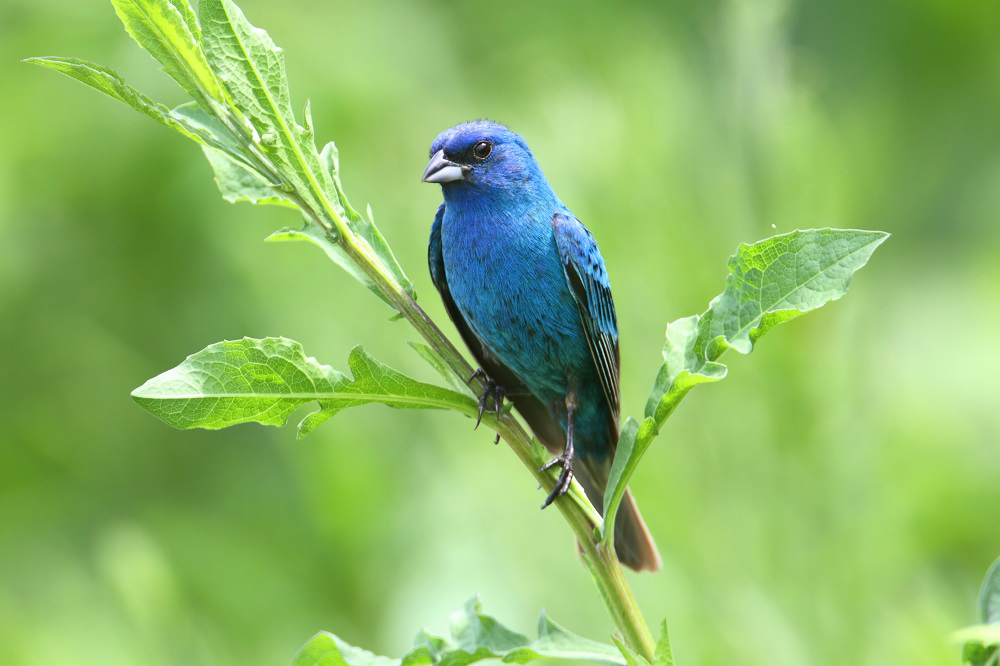In the vibrant tapestry of North American avifauna, few species captivate both seasoned birdwatchers and casual observers alike like the Indigo Bunting (Passerina cyanea). With its stunning azure plumage and melodious song, this small yet charismatic bird has earned its place as a beloved symbol of summer across its range. From the verdant woodlands of eastern North America to the open fields of the Midwest and beyond, the Indigo Bunting’s presence brings joy and wonder to all who encounter it.
Appearance and Plumage
The Indigo Bunting is popular for its breathtaking plumage, particularly among the males. During the breeding season, adult males are adorned in brilliant shades of deep blue, resembling a piece of the summer sky brought to life. This vibrant hue is the result of light scattering through microscopic structures in the bird’s feathers rather than pigmentation, making it especially striking when illuminated by sunlight. In contrast, females and juvenile birds boast more subdued plumage, with mottled brown and pale blue tones that provide effective camouflage among foliage.

Habitat and Distribution
Indigo Buntings predominantly live in open woodlands, brushy areas, and along forest edges throughout their breeding range, which spans much of eastern and central North America. During migration, they may also frequent a variety of habitats, including grasslands, agricultural fields, and even suburban gardens. While they prefer areas with ample shrubbery for nesting and dense vegetation for foraging, Indigo Buntings are remarkably adaptable and can thrive in a diverse array of landscapes.
Behavior and Diet
Despite their small size, Indigo Buntings are energetic and agile birds, often observed flitting among branches or foraging for insects and seeds in the undergrowth. During the breeding season, males establish territories and defend them vigorously through song and occasional displays of aggression towards intruders. Their melodious, flute-like songs ring out from perches as they proclaim their presence and court potential mates. Meanwhile, females diligently build cup-shaped nests from grasses, leaves, and other plant materials, typically hidden within dense vegetation for protection from predators.
Migration and Conservation
Like many migratory songbirds, Indigo Buntings undertake impressive journeys twice a year, traveling thousands of miles between their breeding and wintering grounds. While some individuals migrate across the Gulf of Mexico to reach their wintering grounds in Central America, others may remain in the southern United States throughout the year if food resources are sufficient. Despite their ability to adapt to a range of habitats, Indigo Buntings face threats from habitat loss, pesticide use, and collisions with human-made structures. Conservation efforts aimed at preserving and restoring suitable habitat are crucial for ensuring the continued survival of this iconic species.
Cultural Significance
Beyond its ecological importance, the Indigo Bunting holds cultural significance for many people across its range. Its striking appearance and enchanting song have inspired artists, poets, and nature enthusiasts for centuries, serving as a muse for creative expression and fostering a deeper connection to the natural world. In folklore and symbolism, the Indigo Bunting is often associated with themes of beauty, freedom, and spiritual renewal, its fleeting presence serving as a reminder of the fleeting beauty of summer and the cycles of life.
Conclusion
In the ever-changing tapestry of North American ecosystems, the Indigo Bunting stands as a beacon of beauty and resilience. From its dazzling plumage and captivating song to its vital role in maintaining ecological balance, this diminutive bird embodies the wonder and complexity of the natural world. By conserving their habitats and fostering an appreciation for their unique beauty, we can ensure that future generations will continue to be inspired by the enigmatic charm of the Indigo Bunting for years to come.









